
Posted by Live Yoga Life in Chakras, Yoga Philosophy on October 8th, 2019 4:30 pm
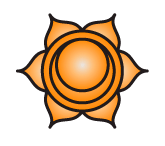 The sacral Chakra is the key to your identity, creativity and sexuality. Intertwined around these issues is the elusive question ‘who am I?’ It brings forth powerful emotions reflective of the symbol of water (it washes away false assumptions to uncover the truth hidden beneath the surface) and the bright strong colour of orange (the ideas, impulses and desires that spring forth from within).
The sacral Chakra is the key to your identity, creativity and sexuality. Intertwined around these issues is the elusive question ‘who am I?’ It brings forth powerful emotions reflective of the symbol of water (it washes away false assumptions to uncover the truth hidden beneath the surface) and the bright strong colour of orange (the ideas, impulses and desires that spring forth from within).
When the sacral Chakra is functioning harmoniously, you will feel a sense of who you are, and be comfortable in your own skin. This will also flow over into how you relate to others especially the opposite sex. You will find it easy to express your creativity and it will flow like a river through you. You will be participating in your life with joy, awe and enthusiasm for the sheer act of living.
When the sacral Chakra is not functioning harmoniously, you will shy away from any activities that require you to look inside yourself and discover who you are. You will feel like you are missing an intangible ‘something” that you need in order to feel complete and whole. You are likely to be yearning for a fulfilling sexual relationship, and keep looking outside of yourself for the solution. Your creativity will be severely curtailed and may describe yourself as boring or plain. You are unable to see the amazing world around you in all its dazzling colour.
Name: Sacral or Sexual Chakra
Location: Above the genitals
Purpose: Self-image, sexuality, procreation, creativity
Colour: Orange
Sound: Vam
Element: Water
Sense: Taste
Symbol: 6-petaled lotus
Associated parts of body: Reproductive system, circulatory system, bladder
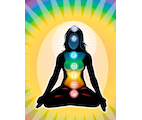 Check out the rest of the Chakras here!
Check out the rest of the Chakras here!
| Join expert teacher, Patty Kikos, in an 8-part journey exploring the Chakras through yoga. Recorded exclusively for Liveyogalife.com, these classes are an excellent practical introduction to the Chakra. Check out the complete set of classes here. |
Posted by Live Yoga Life in Chakras, Yoga Philosophy on October 7th, 2019 4:38 pm
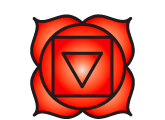 The base Chakra is aptly named as it represents our most primitive instincts and drive, as well as connecting us with the physical world.
The base Chakra is aptly named as it represents our most primitive instincts and drive, as well as connecting us with the physical world.
When the base Chakra is functioning harmoniously, you will feel a deep connection with the world around you. You will feel stable and grounded, and want to participate in shaping life on your earth in harmony with nature. In effect, you will have a deep level of trust in the world to provide and find it easy to achieve your goals in this world.
When the base Chakra is not functioning harmoniously, you will find your thoughts gravitating to worrying about your material possessions and security, or find yourself indulging in food, alcohol, sex, etc. It can manifest as a fixation on your own needs without consideration of others.
In its extreme, anger and aggression are likely when you become upset or irritated, which is triggered by the fear of a loss of something that you believe provides you with security or is crucial to your survival. Ultimately this is only a defensive mechanism, highlighting your lack of trust in the world around you.
The key to realigning your base Chakra is realising that the support you need and the connection you crave is avaialble at all times. It is only when you allow your fears and worries to overwhelm you that the base Chakra moves out of alignment.
Name: Muladhara or Base Chakra
Location: Perineum – between the anus and genitals
Purpose: Survival, groundedness, security, self preservation
Colour: Red
Element: Earth
Sense: Smell
Sound: Lam
Symbol: 4-petaled lotus
Associated parts of body: Bones, teeth, nails, anus, rectum, colon, blood
 Check out the rest of the Chakras here!
Check out the rest of the Chakras here!
| Join expert teacher, Patty Kikos, in an 8-part journey exploring the Chakras through yoga. Recorded exclusively for Liveyogalife.com, these classes are an excellent practical introduction to the Chakra. Check out the complete set of classes here. |
Posted by Live Yoga Life in Chakras, Yoga Philosophy on October 6th, 2019 8:58 pm
The world of chakras is one rich with symbolism of all kinds. It is not a world of literal meaning; rather it is one that opens itself up to the individual on many levels of understanding.
For example, the word ‘Chakra’ comes from the sanskrit word for wheel. On one level, the wheel is a circle that turns by itself. The ‘wheel’ reflects that each of the chakras rotates and turn at its own pace, independently of each other. This is symbolic of the cyclically, ever changing nature of life.
Chakras are referred to as lotuses after the beautiful flower. This water plant (similar to a water lily) is itself symbolic of the chakras. The lotus has its roots deep below the surface in the dark muddy depths, while the flower blooms under the golden light of the sun above the water.
The chakras are found in within each of us and are the bridge from the subtle body. Within the subtle body, they are the hubs between the nadis (or energy vessels). The role chakras play is one of receiving, transforming and distributing prana to the various areas of the subtle and physical body – sustaining and developing us as human beings.
These chakras are located along a central vertical axis at the front of the body. When they are aligned and open, there is a higher ability to create a balanced relationship between the human body, mind, and soul.
Traditional writing mentions around 88,000 chakras. There are, however, seven primary chakras – each significantly related to a core human need. The seven chakras and their corresponding location in the subtle body can be visualised from the top of the head down.
Click on any of the chakra images below to find out more.
| Join expert teacher, Patty Kikos, in an 8-part journey exploring the Chakras through yoga. Recorded exclusively for Liveyogalife.com, these classes are an excellent practical introduction to the Chakra. Check out the complete set of classes here. |
Posted by Live Yoga Life in Yoga article, Yoga Therapy on April 17th, 2016 10:58 pm
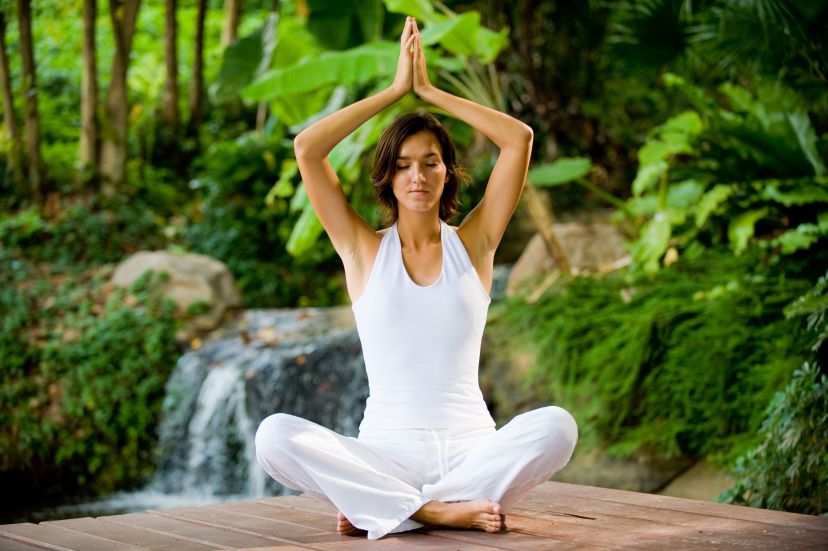
We’ve all known for centuries (nay, millenia!) that yoga is as good for the soul as it is for the body. But until very recently, Western medicine dismissed this as sheer bunkum. As it didn’t involve chemical interventions, surgery, or rigorous moral reeducation, it was (in the minds of old-fashioned scientists) clearly not a valid form of treatment. However, the sheer weight of the evidence is beginning to make an impact. Modern, more open-minded scientists, are taking the potential of yoga to help soothe and heal troubled souls more seriously. They’ve made some significant finds, which are slowly leading to yoga’s acceptance by mainstream medicine in the field of mental health. It’s about time too. With the world’s mental health in the poor state in which it finds itself, we need all the help we can get! Here is what science has to say about yoga’s potential to aid your mental health:
Yoga Can Fight Addiction
When things get tough, far too many of us self-medicate with substances. Addictions are often related to other mental health issues, but they also cause considerable problems in their own right. It appears that yoga can help people both to fight the underlying causes of their addictions, and the addictions themselves. Yoga is increasingly being used by addiction therapists, who say that yoga helps addicts on a number of levels. It combats the sense of detachment from the body which is common among many addicts. It activates the parasympathetic nervous system (more on that later), which calms the stressors which can lead to cravings. It enables the recovering addict to develop a respect for and awareness of their body. And it ‘syncs’ body, mind, and soul powerfully – producing naturally the feeling of intrinsic ‘connectedness’ which many seek through substances.
Yoga Eliminates Stress
We all know anecdotally that yoga is relaxing. But do we know why? It’s all to do with the parasympathetic nervous system. Without getting too technical, two parts of your nervous system are responsible for the automatic processes of being wound up, and of being relaxed. Your sympathetic nervous system is responsible for putting you into ‘fight or flight’ mode, while your parasympathetic nervous system is responsible for the ‘rest and digest’ mode. ‘Fight or flighht’ mode is designed for short bursts of intense energy. It involves the diversion of resources from the organs to the muscles, and the release of chemicals which aggravate your mental state to provoke action. It’s only supposed to last for long enough to outrun or outfight a predator, but sadly, the sympathetic nervous system can’t distinguish between a predator and things like work-based stress. If you’re stressed, you’re in ‘fight or flight’ mode – which for many of us becomes unnaturally prolonged. This is very bad for us. What needs to happen in order for our bodies and our minds to relax is for the parasympathetic nervous system to be activated. This pulls your body back into the resting state at which it operates best. It re-routes resources to where they need to be, and gets the automatic processes like digestion back on track. Mood-levelling and enhancing chemicals are also released, which replace the aggravating cortisol and adrenaline released by the sympathetic nervous system. How can you make yourself switch from the sympathetic to the parasympathetic nervous system? You guessed it – yoga.
Yoga And The Vagus Nerve
Just as you can switch your body into ‘fight or flight’ mode using your mind (imagining terrible scenarios will do it, as will stressful and depressed ruminations!), so you can relax your mind using your body. When we do yoga, we consciously make our bodies mimic the physical symptoms of calm and peace. We regulate our breathing, we make slow, smooth movements. Our hearts tend to slow themselves in response to all of this. As we do all of this, we are signalling ‘calm’ to our vagus nerve. The vagus nerve is the largest nerve in the body. Its job is to report to the brain on the status of every major organ. When we do yoga, the vagus nerve notices the relaxed state of heart, lungs, and limbs. It relays this information to the brain – telling it to calm itself down because everything is clearly ok. This is why, as you do yoga, you seem to feel all of your worries dropping away. Freed from the intensities of the sympathetic nervous system, the brain allows itself to go into a deeper, calmer state of being which is much more pleasant, and much more mentally healthy than the alternative!
Post written by Anne Deal
Posted by Live Yoga Life in Beginners, Yogapedia on March 19th, 2016 3:45 pm
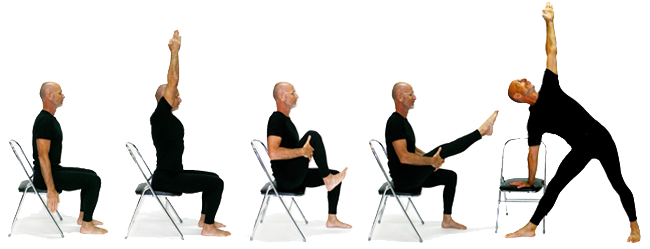
Chair Yoga is a set of yoga poses which uses a chair. Why a chair? Everyone has a chair, yet not everyone can do a a full yoga class. Using a chair is a very useful prop as it provides stability and safety.
As well, anyone who has attended an Iyengar yoga class, which uses props, will realise how much deeper you can go into a yoga pose with the use of props.
For Liveyogalife.com, James Bryan from Knoff Yoga carefully crafted two sets of chair yoga classes:
Posted by Live Yoga Life in Personal Growth, Updates, Yoga Philosophy on July 24th, 2015 8:53 pm
 We came across Yoke Magazine a few months ago. It is an advertising free magazine that appeals to a young and young-at-heart audience, creatives, artists, yogis and food and travel enthusiasts, seeking out inspiration and adventure for a more balanced, happy and creative lifestyle, to empower themselves and at the same time, their community.
We came across Yoke Magazine a few months ago. It is an advertising free magazine that appeals to a young and young-at-heart audience, creatives, artists, yogis and food and travel enthusiasts, seeking out inspiration and adventure for a more balanced, happy and creative lifestyle, to empower themselves and at the same time, their community.
The ancient Sanskrit root for yoke is ‘YUJ’ युज् which is the root word of yoga योग. The word yoga means ‘to be yoked’ – the spiritual concept of ‘being yoked’ means to join or connect, to form a bond, to unite.
It is a subscriber-supported, independently produced high-quality eco-friendly print magazine. Published and distributed by YOKE PUBLICATIONS based in Sydney, Australia. The driving force is Cynthia Sciberras.
Cynthia is currently using crowd funding to publish the third edition which is getting released on 3 August 2015. We encourage you to check it out and support Cynthia in her amazing magazine.